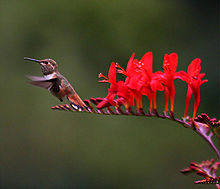- Crocosmia
-
Crocosmia 
Crocosmia Scientific classification Kingdom: Plantae (unranked): Angiosperms (unranked): Monocots Order: Asparagales Family: Iridaceae Subfamily: Ixioideae Tribe: Ixieae Genus: Crocosmia
Planch.Type species Crocosmia aurea
(Pappe ex J.D. Hooker) PlanchonSpecies See text.
Crocosmia (
 /krɵˈkɒzmiə/; J.E. Planchon, 1851)[1] is a small perennial genus in the iris family Iridaceae, native to the grasslands of Cape Floristic Region, South Africa.
/krɵˈkɒzmiə/; J.E. Planchon, 1851)[1] is a small perennial genus in the iris family Iridaceae, native to the grasslands of Cape Floristic Region, South Africa.They can be evergreen or deciduous perennial herbs, that grow from basal underground corms. The basal, alternate leaves are cauline (meaning, belonging to the stem) and distichous (meaning, growing in two vertical ranks). The leaves are linear or lanceolate. The blades are parallel-veined. The margin is entire. The corms are unusual in forming vertical chains with the youngest at the top and oldest and largest buried most deeply in the soil [1]. The roots of the lowermost corm in a chain are contractile roots and drag the corm deeper into the ground where conditions allow. The chains of corms are fragile and easily separated, a quality that has enabled some species to become invasive and difficult to control in the garden.
They have colourful inflorescences of 4 to 20 vivid red and orange subopposite flowers on a divaricately branched stem. The terminal inflorescence can have the form of a cyme or a raceme. These flower from early summer well into fall. The flowers are sessile on a flexuose arched spike. The fertile flowers are hermaphroditic. All stamens have an equal length. The style branches are apically forked. They are pollinated by insects, birds (hummingbirds) or by the wind. The dehiscent capsules are shorter than wide.
They are commonly known in the United States as coppertips or falling stars, and in Britain as montbretia. Other names, for hybrids and cultivars, include antholyza, and curtonus. The genus name is derived from the Greek words krokos, meaning "saffron", and osme, meaning "odor".[2]
Contents
Cultivation
Crocosmias are grown worldwide, and more than 400 cultivars have been produced. Some hybrids have become invasive species especially C. x crocosmiiflora hybrids which are invasive in the UK, New Zealand, the American Pacific Northwest, and probably elsewhere.
Crocosmia are winter-hardy in temperate regions. They can be propagated through division, removing offsets from the corm in spring.
Species
- Crocosmia ambongensis
- Crocosmia Krakatoa
- Crocosmia aurea (Falling Stars)
- Crocosmia cinnabarina
- Crocosmia fucata (Namaqualand, Cape region)
- Crocosmia luciferans
- Crocosmia maculata
- Crocosmia masonorum (Giant Montbretia)
- Crocosmia mathewsiana
- Crocosmia paniculata (Aunt-Eliza)
- Crocosmia pauciflora
- Crocosmia pearsei
- Crocosmia pottsii (Pott's Montbretia)
Natural hybrids
- Crocosmia x crocosmoides
- Crocosmia x latifolia
Garden hybrids
- Crocosmia x crocosmiiflora (montbretia)
References
- De Vos, M.P. (1999) Crocosmia. Flora of Southern Africa 7: 129-138.
- Peter Goldblatt, John Manning, Gary Dunlop, Auriol Batten - Crocosmia and Chasmanthe (Royal Horticultural Society Plant Collector Guide)
- Kostelijk, P.J. (1984) Crocosmia in gardens. The Plantsman 5: 246-253.
Categories:- Iridaceae genera
- Flowers
- Garden plants
Wikimedia Foundation. 2010.



